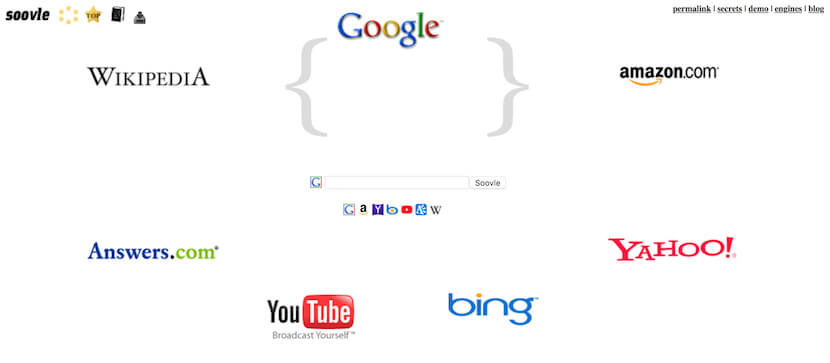Did you know that Amazon is the top search tool for shoppers looking for products? It even beats Google, according to data from Survata. So whether Amazon is your only selling channel or one of several, making sure your products are searchable is key.
Amazon SEO is a lot different from Google SEO. Though both are rooted in keyword research and on-page optimization, SEO is far more complex than that. And Amazon SEO has several commonalities with “regular” SEO, but there are also nuances unique to the ecommerce marketplace.
We’ll look at what Amazon SEO is and how you can do the keyword research and publish listings that will put you at the top of the search results.
What is Amazon SEO?
Amazon SEO is when a seller optimizes product listings to be easily found through Amazon’s on-site search tools. SEO is “search engine optimization” — when referred to as SEO, we’re talking about Google mainly, but Amazon SEO is specific to searches performed on the Amazon website. Optimizing your site for Amazon SEO involves keyword research and on-page optimization.
“I actually think Amazon SEO is one of the most overlooked tactics,” says Joe Sloan, marketing coordinator at Jurassic Sands. Jurassic Sands has doubled sales for the past three years, a large part, Sloan says, attributable to their Amazon SEO strategies.
Amazon’s A9 algorithm
Depending on how familiar you are with Amazon SEO, you may have heard of the A9 algorithm. A9 is what Amazon calls its search tool, and the algorithm is the “formula” the tool uses to judge a product page’s relevance to entered search terms.
“A9 helps customers find the best products, taking into account keywords that meet their preferences, past purchases, and includes possible upsells and cross-sells,” says Rohan Ayyar of SEMrush, a digital marketing toolkit for SEO, PPC and content marketing.
Like Google, Amazon doesn’t tell the entire story behind the algorithm, leaving sellers and marketers to do their own independent research to try and crack the code.
How to do keyword research
“The most efficient strategy able to significantly improve your metrics for Amazon listings is proper keyword research,” says Ayyar. “Examine the way Amazon users are searching for products and try to identify the most successful keywords in terms of enhancing your listings and actually making sales.”
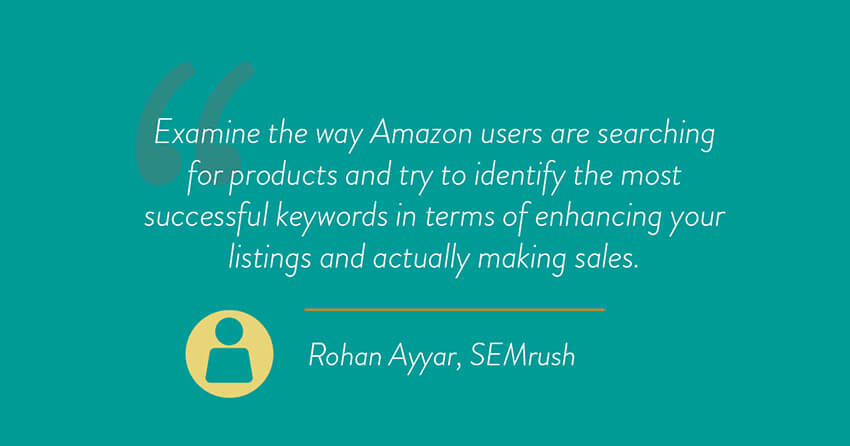
“For this, you can use dig into Amazon’s own sponsored ads and customer reviews to get additional, relevant keyword suggestions,” he says. “You can also use SEMrush Keyword Overview for a list of related terms and Google Keyword Planner for a better understanding of search volumes.”
Here’s a list of a bunch of tools you can use to do keyword research for Amazon SEO:
- Keyword.io
- Scientific Seller
- MerchantWords
- Keyword Scout (from Jungle Scout)
- WordTree
- Sonar
- Soovle
See your competitor’s secrets in the source code
Looking for a little-known shortcut? “If you view the source code of an Amazon item page, and look for the meta-tag ‘keyword,’ you’ll be able to see what search keywords they’re including for an item,” says Flynn Zaiger, CEO of Online Optimism. “It’s a great way to get a leg up on the competition.”
Here’s how to find your competitors’ keywords by the source code:
1. Right-click anywhere on the product page and click View Page Source.
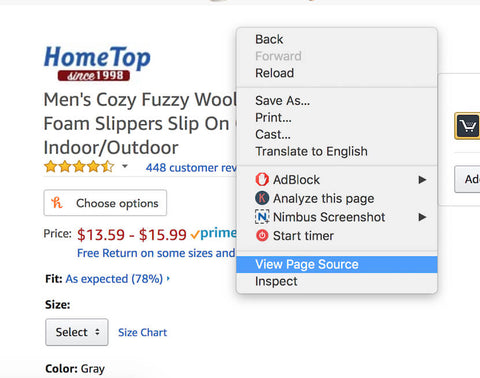
2. Conduct a search for “keyword” and make note of the terms used in these fields. Pay special attention to keywords associated with title tags, meta descriptions, the keywords tag, image title tags and image alt tags.

In this example, it looks like the following words are targeted:
- Men’s
- cozy
- fuzzy
- wool
- fleece
- memory foam
- slippers
- slip-on
- clog
- house shoes
- indoor/outdoor
3. Put the words together to form phrases. For this example, we might be looking at:
- Men’s cozy house shoes
- Fuzzy wool slip-on clog
- Indoor/outdoor fleece slippers
… among others. These are phrases and words you’ll want to incorporate into your on-page optimizations.
Amazon SEO tips: Optimizing your product pages
Once you’ve culled a list of keywords, Amazon specialist Shannon Roddy recommends picking to the top two or three in terms of search volume and relevance. “Place them in your title, and use all of them throughout your product features and descriptions,” he says. “This reinforces the relevance of the keyword to the customer and Amazon, while also helping your product rank on Google.”
And optimizing your product pages isn’t just good for your bottom line. “[It will] also allow your Amazon Sponsored Product Campaigns to run effectively with a higher click-through rate and lower ACoS,” Roddy says.
Here’s where you’ll want to make sure you incorporate your Amazon SEO keywords:
- Product title
- Product description and bullet points
- Product price
- Product images
- Seller name
- Hidden keywords
- Amazon reviews
- Categories
- Conversion rate
- Promotion
Product title
The product title is the first and foremost place to put your keywords.
David Mitroff, business consultant and founder of Piedmont Avenue Consulting, Inc., strategically used specific keywords in the title of his book, Online Business Growth Strategies: A Practical Nine-Step Guide to Digital Marketing.
“The main focus that helps books rank higher is putting keywords within the title. For example, in my title I have the words ‘business’, ‘marketing’ and ‘digital,’” he says. “These keywords help me show up higher in an Amazon search.”
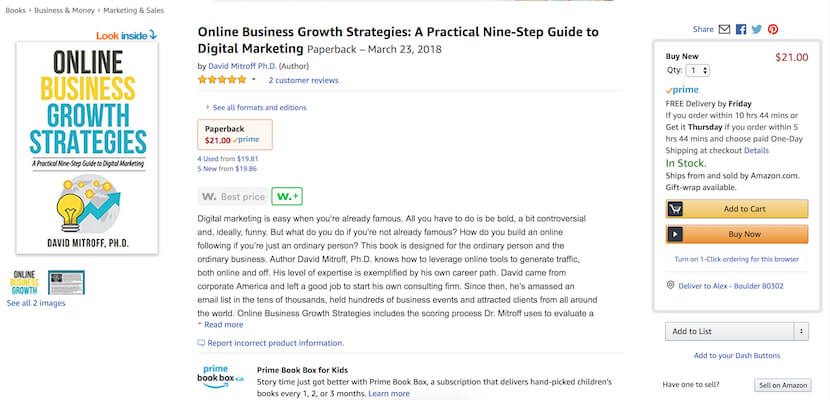
Product description and bullet points
Next comes your actual product description. Here, you can get extremely specific and incorporate any long-tail keywords you’ve identified. “Be descriptive,” Sloan says. “Amazon has tons of fields to help answer customer questions so there’s no hang-up in making that purchasing decision.”
Zaiger echoes this advice, pointing out that Amazon doesn’t knock sellers for having lengthy descriptions. “By creating extra content, you’ll be able to include more keywords,” he says. “Most buyers won’t actually read that far into your product description (which is why Amazon includes the specific product features at the top).”
Pay attention to your product title and bullet points. “Not only is it more descriptive for Amazon searchers, but Amazon’s search index is far more likely to recognize keywords that are placed here,” says Greg Bullock, marketing manager at TheraSpecs. You can’t exactly incorporate keywords into your pricing on Amazon, but you can use pricing as a way to jump in the rankings. The lower you go, the higher you’ll show up when the page is sorted according to price. Another Amazon SEO tactic that doesn’t involve keyword optimization is by creating engaging product photos for your listing. “Amazon works in a similar fashion as Google,” says Sloan. “The higher the click-through rate of your product, the more often Amazon will feature it.”
If you have the option, include keywords in your seller name. This is especially useful if you operate in a specific niche. Jurassic Sands, for example, has “sand” in the name; and Sports Research sells fitness-related products. “Some of the most overlooked items that we have seen help our clients grow in the rankings are much less visible and found in the other details of a product,” says Gabe Ray, VP of operations at Evolved Commerce. That’s where “hidden” keywords come in. “We fill out as much information as we can in the Keywords and More Details sections of Seller Central,” Ray says. “Adding things like Target Audience, Subject Matter and even allowing for Gift Wrap and Messaging can … set you apart and shows Amazon that you’re actively searching for traffic and sales. The more you fill out, the more opportunities you have to be indexed and found in searches.” Reviews are one of Amazon’s top ranking factors, says Jeff Martin, director of SEO at HealthLabs.com. But if you’re just starting out, you don’t have the luxury of tons of reviews. “Depending on your product and niche, one way [to get reviews] is to give a very large discount on your first dozen or so products in exchange for a review,” he says. After you’ve gotten some traction, discounts aren’t going to be a sustainable way to grow your business. “Subscribe to a review service that sends follow-up emails which allow the customer to easily write a review of your product post-purchase,” Martin suggests. Chris Hornak, owner of Blog Hands, a blog-writing service for small businesses and digital marketing agencies, agrees with this advice. “Once you have sales, you need to proactively ask for customer reviews because those will also help improve your position.” Hornak recommends JumpSend as a tool to execute this approach. It’s important to correctly list and categorize your products. Though many sellers intentionally miscategorize to avoid higher dues to Amazon, this can actually hurt your search ranking. “I’ve seen business that place their products in home and garden over children’s toys because Amazon takes a smaller percentage, but this can greatly affect being found and being placed alongside competitors,” says Sloan. The listing below from Jurassic Sands is categorized under Toys & Games > Sports & Outdoor Play > Sandboxes & Accessories — instead of a home and garden-related category. Remember how we noted that improving your product photos would help conversion rates, which would signal to Amazon that your products are worth high rankings? Imagery isn’t the only element on the page to consider: You’ll also want to make sure your Amazon listing product descriptions are written to convert. “Informative bullets can accurately present all product information and help turn a shopper into a buyer,” says Pam Galeone, director of brand marketing at Amify. “Enhanced Brand Content can differentiate your brand, depict your product feature/benefits and build brand equity. This all leads to an increase in conversion rate.” Still hurting for sales? Tried some paid promotional tactics to drive traffic to your product listings. This will then give those conversion signals to Amazon that help with SEO. Amazon Advertising is one great way to get started. “One of the best ways to generate organic keywords for SEO on Amazon is to set up a Sponsored Products advertising campaign with automatic targeting,” says Bullock. “Run this type of campaign for at least a few weeks and then download the Search Term report; this will show you in exactly which searches and keywords your sponsored products appeared as well as which terms converted best. Once you have that data, you can choose to add the most relevant keywords to your titles and/or bulleted details in order to start showing up organically for those same searches.” Optimizing for Amazon SEO is one thing, but that doesn’t mean you should throw Google to the wayside completely. In fact, focusing on Google’s organic search is one of the best and most-overlooked tactics in Craig De Borba’s opinion. “Although Amazon hasn’t disclosed what increases their Amazon Best Sellers’ Rank (BSR), as Amazon sellers we can extrapolate that increased traffic, sales and reviews does influence BSR,” says the Amazon SEO specialist at Onpoint Internet Marketing. One way to do this is to generate backlinks from high-ranking websites and blogs. “As a seller we can drive traffic with Amazon PPC, but a better long-term traffic strategy is to rank the product in Google search,” De Borba says. Mitroff uses this approach on his own website and social media channels, which you can do as well. “I write blog posts using SEO for my website that helps my company rank higher on Google,” he says. “At the bottom of these blog posts, I’ll write a small paragraph advertising my book along with a link to the Amazon page as well as a picture of the cover. Being consistent across all different media platforms helps with SEO and attracting more people to your content.” “Remember, optimization is an ongoing process and needs your regular contribution,” says Ayyar. It’s all about testing, learning and optimizing, especially in an ever-changing digital commerce world.
“Include more variations on how people talk about the product that you’re selling. This is key to getting the best results, increasing your search volume, and rising to the top of Amazon searches.” Flynn Zaiger, Online Optimism

Product price
Product images
Seller name
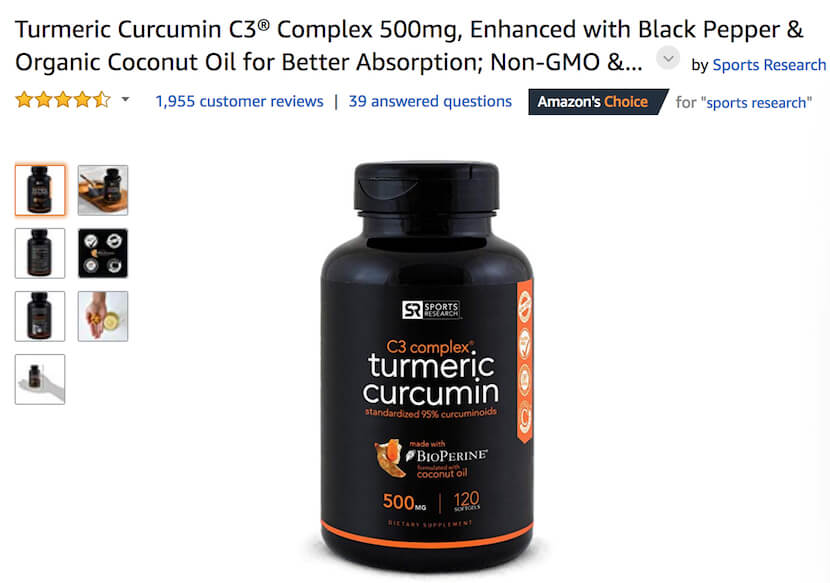
Hidden keywords
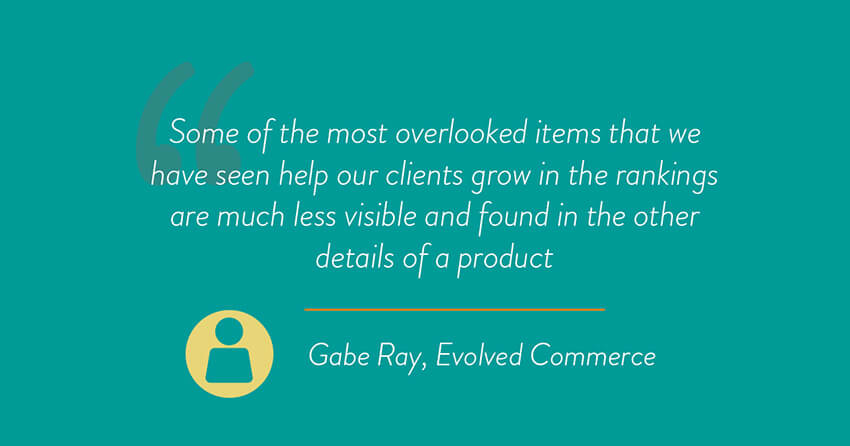
Amazon reviews
Categories

Conversion rate
Promotion
Beyond Amazon: More SEO tips


